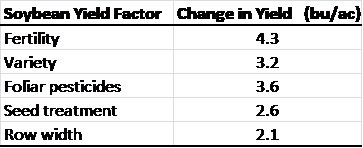Crop production is the process of managing plants to maximize sunlight interception, carbon assimilation (photosynthesis) and storage of carbohydrates that ultimately produce grain, fruits and fiber to benefit mankind.
Crop production is the process of managing plants to maximize sunlight interception, carbon assimilation (photosynthesis) and storage of carbohydrates that ultimately produce grain, fruits and fiber to benefit mankind. The assimilation process can be reduced significantly by low soil fertility, insufficient plant nutrient application, pests, soil type and weather. Producing soybeans involves managing all controllable inputs to optimize plant utilization of photosynthesis.
Production factors: Dr. Fred Below’s work with Six Secrets of Soybean Success1 listed six influential factors that include 1) weather, which has greatest impact on yield response, 2) soil fertility needs to be maintained with balanced crop nutrition, 3) variety selection to optimize genetic potential with intensive management, 4) utilize pesticides to protect yield potential, 5) enhance stand establishment with seed protectants and 6) employ narrow row spacing to maximize light interception by the soybean canopy. Table 1 reveals the effect of each factor on yield.
Table 1: Influence of production factors on soybean yield.

Values are averaged across 6 trials in one year.
Nitrogen (N), phosphorus (P), potassium (K) and sulfur (S) are the key nutrients for crop growth and development. Applying these nutrients can produce synergistic relationships when one factor influences the ability of plants to use the second factor. Therefore, crop production and quality can be improved by fertilizer. For example, literature has reported that N and S affect the level and composition of seed storage proteins in soybean.2
Nitrogen can provide an early start for soybean seedlings, especially under intensive management. Nitrogen fixation begins at V3 growth stage, so adding approximately 20 – 30 lbs./A N should be sufficient. An over-application of N can reduce activity of N-fixing bacteria. Research studies have shown that N fixation was reduced when legumes were grown in sulfur deficient soils. Symbiotic N fixation of legumes is very sensitive to S deficiency and growth of S-deficient legumes may be limited by N supply.3
Phosphorus is critical for maximizing soybean yields. Phosphorus is interactive in photosynthesis, respiration, energy storage and transfer, cell division, cell enlargement and several other processes in plants.4 Soil test levels should be in the optimum range for your area and soil type. Phosphorus should be applied before each soybean crop to at least cover anticipated removal rates.
Potassium demand is greatest during early reproductive growth stages. It is not a part of the chemical structure of plants, but it is critical in functionality of many regulators that control growth and development.5 Potassium should be applied before each soybean crop to at least cover anticipated removal rates.
Sulfur is an essential building block in chlorophyll development and protein synthesis.6 Sulfur is required by the rhizobia bacteria in legumes for nitrogen fixation. And in soybean plants there are two key amino acids that contain sulfur, cysteine and methionine. In general, soybeans utilize about as much sulfur as they do phosphorus.7 Sulfur comes from organic matter mineralization, atmospheric deposition and supplemental fertilization.
Achieving major yield advantages in soybean production has been very challenging. The national average production only increases 2/3 of a bushel per year. Research supported by TIGER-SUL demonstrates the importance of including S and micronutrients, along with P and K, to balance crop nutrients. Figure 1 reveals a significant 5-bushel yield advantage when S and manganese were included in the soil fertility program. A yield response of 5.3 bushels/ac x $9.00/bu soybeans = $47.70/ac gross income less cost of S at $0.35/lb. x 34 lbs./A of Tiger 90CR = $11.90/ac with a net return of $35.80/A ($47.70/A gross income – $11.90/A S cost = $35.80/A).
Figure 1. Soybean yield in response to Tiger sulfur and micronutrient products.
Values average across 3 years, 10 locations, and 4 states.
If an annual application of S is not part of your fertility program, maybe you ought to consider it.
- Haegele JW, Below FE. The Six Secrets of Soybean Success. 2013. Illinois Soybean Association.
- Kaiser DE, Kim K. Soybean Response to Sulfur Fertilizer Applied as a Broadcast or Starter Using Replicated Strip Trials. Agronomy Journal 2013;105:1189-1198.
- Stanle, HD, Reisenauer HM. “Roles and Requirements of Sulfur in Plant Nutrition.” In: Tabatabai MA, ed. Sulfur in Agriculture. Agronomy Monograph 27. 1986.
- International Plant Nutrition Institute (IPNI). 1999. Phosphorus for Agriculture.
- International Plant Nutrition Institute (IPNI). 1998. Potassium for Agriculture.
- Hitsuda K. Sulfur Management for Soybean Production. In: Jez J, ed. Sulfur: A Missing Link Between Soils, Crops, and Nutrition. Agronomy Monograph No. 50. 2008.
- Oldham L. Secondary Plant Nutrients: Calcium, Magnesium, and Sulfur. Mississippi State University Publication IS1039. 2017.





 and then
and then